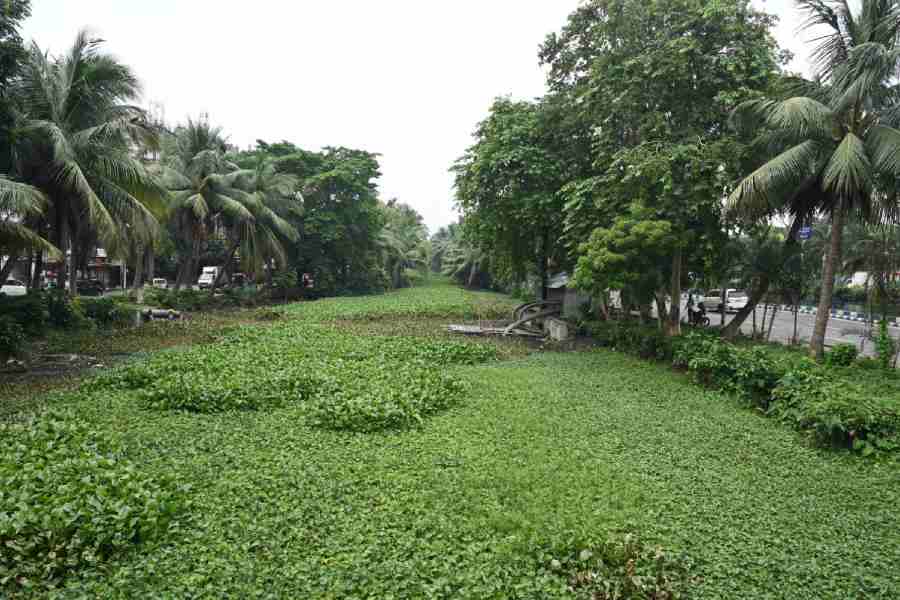Mosquitoes are laying siege to the residential blocks that border the Kestopur Canal and the Eastern Drainage Canal.
Several residents said they were forced to keep their doors and windows shut at all times.
The water of the canals is very slow-moving or stagnant in several places.
In several stretches of the Kestopur Canal, the water can no longer be seen, thanks to a thick carpet of water hyacinth.

A stagnant stretch of the Eastern Drainage Canal in Chingrighata on Wednesday
The Kestopur Canal starts from the Hooghly, near Chitpore lockgate, with the name Circular Canal. It takes the name Bhangarkata Canal and drains water into the Bidyadhari. The canal is a key cog in the drainage network in areas like Salt Lake, Baguiati, Kestopur, Dum Dum, Lake Town and Rajarhat. The Eastern Drainage Canal, too, drains out rainwater from Salt Lake.
On Wednesday Metro found several stretches of the Kestopur Canal that were completely covered in water hyacinth in Lake Town and Kestopur.
Debabrata Maity, an associate professor of botany at Calcutta University, said water hyacinth was an invasive species that proliferates in stagnant water.
“Massive biomass is produced by water hyacinth, and if left unharvested, it breaks down in the water bodies where it thrives, returning the nutrients it had taken up. Which in turn responsible for eutrophication, the process through which a waterbody becomes exceptionally nutrient-enriched, causing a proliferation of basic plant life, such as algae,” said Maity.
“Bacteria begin to break down the organic stuff left behind after the algae die. The amount of oxygen consumed by these bacteria is too high. This raises a waterbody’s biological oxygen demand and results in a hypoxic (low oxygen) environment that is unfavorable for aquatic life forms,” said Maity.
A senior official of the Bidhannagar Municipal Corporation (BMC) said they
had identified several stretches of Kestopur and Eastern Drainage Canal that have slow-moving and stagnant water.
The official said that the civic body is going to send in a request to the state irrigation department to release more water into the canals so that the water keeps moving and mosquitoes cannot breed.
Banibrata Banejeee, the mayoral council member in charge of health at the BMC, said that a team from the civic body has already surveyed to find out the potential mosquito breeding grounds.
“We are regularly spraying larvicide in the canal waters. Civic teams are visiting every seven days to spray larvicide. We are also going to send in a letter to the state irrigation department asking them to release more water in the canals,” said Banerjee.
According to Banerjee from January till Wednesday, eight dengue cases had been recorded in 41 Wards of
the BMC.
An official of the state irrigation department said that the Kestopur and the Eastern Drainage canals had both been dredged and added that they must be cleared of water hyacinth and garbage before they released the water.
“These two canals are crucial for the drainage system in the northern part of the city. The monsoon is here and if we release more water into the canals before they are cleared of obstacles such as the water hyacinths and garbage, the canals might breach their banks,” said the official.
The Aedes aegypti mosquito that causes dengue can breed even in a coin-sized blob of water.










